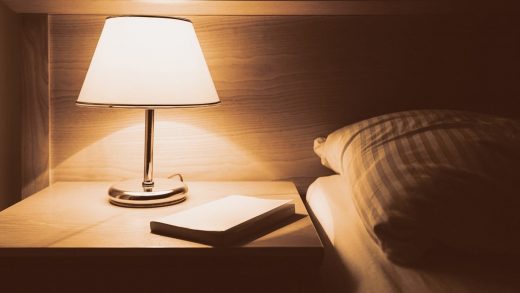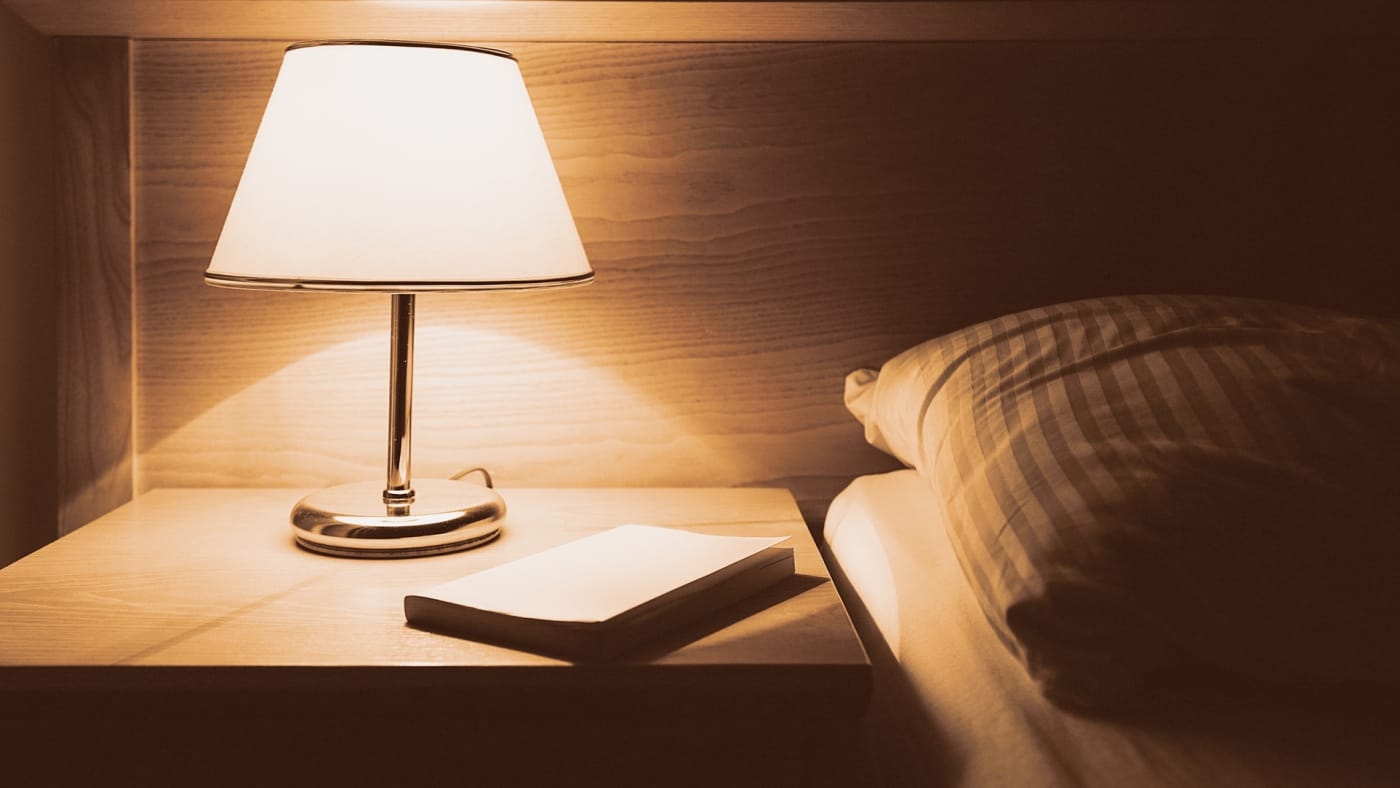One way to improve your sleeping arrangement is simply to approach it from four of your five senses (everything minus taste). Here’s how, in order of importance.
1. Sight
Light directly impacts your ability to sleep, so if you only make one change to your bedroom setup, commit to addressing light-related issues above all else.
There’s a spectrum of frequencies within all the light we see (as well as the light we don’t see), called wavelengths, and it’s within the range of 450–480 nanometers, which we call “blue light,” that’s worth looking out for. When exposed to the eye, this blue range causes the eye’s “melinopsin” (a photopigment) cells to signal the brain to turn off the melatonin, the chemical that tells your body it’s time for bed. This isn’t good when you’re trying to fall asleep. Bedside table lamps, TVs, phones, tablets, and laptops all emanate those blue-light wavelengths.
So while darker is generally better, filtered light is also better. Here are some products and techniques for eliminating blue light:
Blackout shades. Yes these do work, and they work well. If your bedroom faces east, you may be getting a lot of sunlight in the morning, which can cut into the last leg of your sleep cycle. If you try blackout shades, avoid just hanging a liner behind your ordinary drapes. You’re better off with a product that has two to three layers to really block out light (as a bonus, these tend to keep your room cool–which matters, too, as I’ll explain below).
Specially filtered light bulbs. These are now commercially available (online and at many hardware and lighting stores) and priced around $20 or so, designed with a built-in filter to reduce blue light.
Blue-blocker glasses. I love these and wear them often. They’re ordinary glasses with lenses that filter blue light from your eyes. Yes, they look a little amber, but the data suggests they have a positive impact.
Eye mask. They’ve been around forever and can be very effective. Pro tip: Get one with an elastic strap for a personalized fit, and look for extra padding on the part that touches your face, including under your eyes. Light can find sneaky ways to creep in!
Nightlight. Don’t turn on the table lamp or overhead lights if you get up at night. Use a gentle nightlight instead.
2. Sound
Until recently, sleep researchers believed noise was the biggest sleep disruptor, but we’re learning that tends to be true during sleep more so than while falling asleep. The brain continues to process sound while sleeping, and while certain sounds can wake you up, others can be soothing and actually help you fall asleep. Here’s how to add, eliminate, and mask sound in your bedroom:
Sound machine. I prefer the ones with ocean sounds, and there’s data suggesting these can help a person fall asleep; same goes for playing instrumental music. Some sound machines will automatically increase or decrease their own volume based on the background noises they pick up, which is kind of cool but not as helpful as you might think. Others come preloaded with meditation and relaxation exercises, which can actually be really effective at lulling you to sleep.
Earplugs. Look on the package for the kind that block out noise levels of 32 and below; this way, you can still hear the smoke alarm (very important!). I like the ones that look like a cone and then have several layers. The moldable ones tend to be hard and hurt, and the spongy ones are less effective.
3. Touch
What touches our skin while we sleep has significant effect on our sleep experience, but the biggest factor here is temperature, not texture. Our sleep rhythms follow the rhythms of our core body temperature, which also fluctuates. Generally, rising temperatures make us more alert, and lower temperatures make us sleepy. With that in mind, here’s what to consider in your bedding and pajamas:
Materials. Look for natural, breathable fibers like wool, down (unless you’re allergic), cotton, linen, and silk. Try to avoid synthetic materials since they have a tendency to trap heat and moisture, which can make you warm.
Care. Wash it all once a week, including your duvet (especially if animals sleep in your bed). That may sound like a lot, but it can help keep your bedding clean and cool, rather than trapping dust and dirt particles (and flinging them into the air whenever you move).
Size and fit. Make sure your bedsheets fit properly and snugly. Getting wrapped up in oversize linens will raise your body temperature.
Feel. You want your textiles to feel soft and comfortable, which gives your body an unconscious signal to relax, helping you drift off to sleep. Don’t fall for the 1,000 thread-count sheets, though! The largest number of fibers you can get into a sheet is about 500, so don’t believe the hype.
4. Smell
Comparatively the least important, smell is something many people don’t think about in relation to sleep quality, but it still has an impact. Smell is one of our most powerful senses. It feeds directly into the limbic system, which is in charge of our impulses, sexual drive, and emotions–all of which can impact sleep quality. Certain scents can stimulate alertness while others promote calmness. Air quality can impact sleep, too. So here are a few ideas:
Aromatherapy. A few scents are known to encourage relaxation, including lavender and ylang-ylang. Consider a diffuser or pillow spray to distribute essential oils gently throughout your bedroom. Whatever you do,
avoid any and all candles! Fire and sleep should never mix.
Open windows. This can help improve air circulation on temperate evenings, but think twice if the air quality outside is poor, or if opening the windows will introduce more light and noise.
Air filter. This can remove possible allergens that may lead to nasal congestion and harm your sleep.
Humidifiers and dehumidifiers. Depending on the level of moisture in your room, you may want to control humidity, particularly if the air is too dry–a greater likelihood in cold weather and at the higher floors of a building.
Optimizing your bedroom is all about taking small steps that can add up to a dramatically improved sleep quality. Try out a few of these and see what works best. It’s not hard to find a combination that gives you a more restful night’s sleep and the sweet dreams you deserve.
Michael Breus, PhD, is a board-certified sleep specialist and founder of TheSleepDoctor.com, as well as the author of The Power of When.



